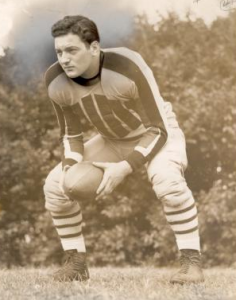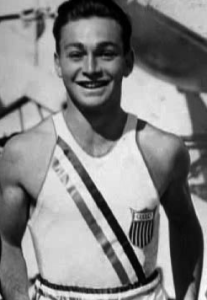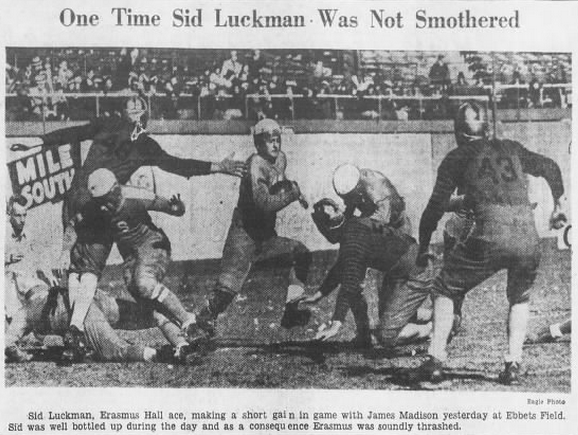This doesn’t have anything to do with pro football, per se, but it’s kinda cool nonetheless. Here’s the headline that ran across Page 9 of the Brooklyn Eagle on Oct. 13, 1934:
Yes, that’s Marty Glickman, the future sportscaster (Giants, Jets, Knicks, etc.), who helped the Madison High hand mighty Erasmus Hall a 25-0 loss, its first in the regular season in four years. But that’s not why I’m posting about it. I’m posting about it because in the second quarter, Glickman intercepted a
pass and returned it 75 yards for a touchdown. The passer? Sid Luckman, Erasmus’ single-wing tailback, who would go on to quarterback the Bears to four NFL titles. For more details, read the story by the Eagle’s Harold Parrott.
Glickman reminisced about the game in the autobiography he wrote with Stan Isaacs, The Fastest Kid on the Block:
Two plays stand out from that game. I was the tailback and signal caller in the single wing, and early in the game I quick-kicked on third down. I kicked it over Luckman’s head — he was the safety — and the ball rolled dead at about the 8-yard line. It must have gone about 65 yards. It completely surprised them. We held, Luckman punted out, I caught the ball at midfield and ran it back to the 35-yard line. We scored a couple of plays later. . . .
Later, Luckman threw a pass diagonally downfield that I intercepted at our 25-yard line. Both Sid and I were off to the side, and he was the only one who had a shot at me. He tried to race over and tackle me, but there was no way he could catch me. Whoosh, I went 75 yards for the touchdown, and we won the game. We later beat Roosevelt, 12-0, for the city championship.
Luckman had another memory of his rival in his autobiography, Luckman at Quarterback:
We fought each other tooth and nail in every game we played, with the result that we became chums off the field, almost inseparable each summer, though all we had in common was a charley-horse I handed Marty on one play, and a bruised ear he gave me on a hard tackle. How did we become friends? I guess Ma Luckman was responsible for that. Ma never did like “feuds” of any sort, and especially failed to understand how the papers could dare write that Luckman and Glickman were ready to “tear into each other again next Saturday.” Her little boy, she sincerely felt, had no such malice in his heart.
So she called up Marty’s folks and invited them over for supper, figuring on patching up the “feud.” The next day Marty and I took in a pro game at the Polo Grounds and watched someone else fight it out for a change.
Actually, Glickman was more celebrated for his track exploits than his football prowess. (Note that Parrott refers to him as “the city’s 100-yard champion sprinter.”) Two years later, at HItler’s
Olympics in Berlin, he was in line to run in the 4-by-100-meter relay, but he and another Jewish member of the U.S. team, Sam Stoller, were replaced at the last minute. Guess why.
If you wanted to do an American version of Chariots of Fire, Glickman and Luckman would be the perfect athletes to build it around. Sid, of course, had his own burdens to bear. His father was convicted of murder in 1936 and spent the rest of his life in Sing Sing prison. One of these days, maybe I’ll get around to writing a screenplay.
Finally, in case you missed it: The Madison-Erasmus game was played at Ebbets Field, home of the baseball and football Dodgers, before a crowd of 20,000. That was more than the football Dodgers drew, on average, that season (less than 12,000, if Total Football‘s figures are accurate). Football in the ’30s: a different world.




